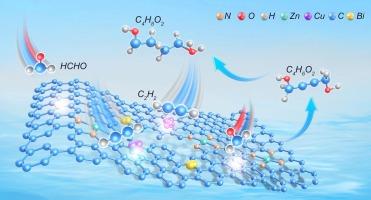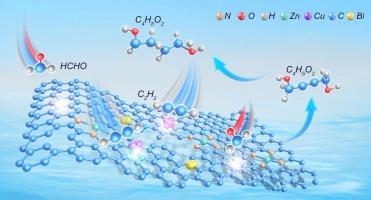‘N-Defective MOF-derived ZnCuBi catalysts with Zn-N sites: Stabilizing Cu+/Cu0 active interfaces for efficient formaldehyde ethynylation to 1,4-butynediol
IF 6.5
1区 化学
Q2 CHEMISTRY, PHYSICAL
引用次数: 0
Abstract
The development of efficient catalysts under reducing atmospheres remains a significant challenge. In this study, a series of ZnCuBi catalysts were synthesized by incorporating nitrogen defect sites into a porous carbon–nitrogen network while constructing Zn-N active sites and Cu+/Cu0 active interfaces (ZnCuBi-NvC). Polyvinylpyrrolidone (PVP) modified ZnBiCu-BTC (PVP@ZnBiCu-BTC) served as a precursor, with polyvinylpyrrolidone acting as a nitrogen source during catalyst preparation. The incorporation of Bi enhanced the dispersion of Cu and Zn species. Synergistic catalytic behaviour was demonstrated through experimental characterization and DFT calculations. The Zn-N structure significantly enhanced the adsorption and activation of formaldehyde, while interfacial interactions between copper species promoted acetylene activation. The N-defect structure also facilitated electron transfer, stabilizing the Cu+/Cu0 active interface. The ZnCuBi-NvC catalyst exhibited 95 % selectivity for 1,4-butanediol (BD) in a cyclic activity test under a reducing atmosphere containing acetylene and formaldehyde.


n-缺陷mof衍生的具有Zn-N位点的ZnCuBi催化剂:稳定Cu+/Cu0活性界面,有效地甲醛乙基化为1,4-丁炔二醇
在还原气氛下开发高效催化剂仍然是一个重大挑战。本研究通过在多孔碳氮网络中加入氮缺陷位点,同时构建Zn-N活性位点和Cu+/Cu0活性界面(ZnCuBi- nvc),合成了一系列ZnCuBi催化剂。以聚乙烯吡咯烷酮(PVP)改性ZnBiCu-BTC (PVP@ZnBiCu-BTC)为前驱体,聚乙烯吡咯烷酮作为氮源制备催化剂。Bi的掺入增强了Cu和Zn的分散性。通过实验表征和DFT计算证明了协同催化行为。Zn-N结构显著增强了甲醛的吸附和活化,而铜种之间的界面相互作用促进了乙炔的活化。n缺陷结构也有利于电子转移,稳定了Cu+/Cu0活性界面。在含有乙炔和甲醛的还原气氛下,zncube - nvc催化剂对1,4-丁二醇(BD)的选择性为95% %。
本文章由计算机程序翻译,如有差异,请以英文原文为准。
求助全文
约1分钟内获得全文
求助全文
来源期刊

Journal of Catalysis
工程技术-工程:化工
CiteScore
12.30
自引率
5.50%
发文量
447
审稿时长
31 days
期刊介绍:
The Journal of Catalysis publishes scholarly articles on both heterogeneous and homogeneous catalysis, covering a wide range of chemical transformations. These include various types of catalysis, such as those mediated by photons, plasmons, and electrons. The focus of the studies is to understand the relationship between catalytic function and the underlying chemical properties of surfaces and metal complexes.
The articles in the journal offer innovative concepts and explore the synthesis and kinetics of inorganic solids and homogeneous complexes. Furthermore, they discuss spectroscopic techniques for characterizing catalysts, investigate the interaction of probes and reacting species with catalysts, and employ theoretical methods.
The research presented in the journal should have direct relevance to the field of catalytic processes, addressing either fundamental aspects or applications of catalysis.
 求助内容:
求助内容: 应助结果提醒方式:
应助结果提醒方式:


